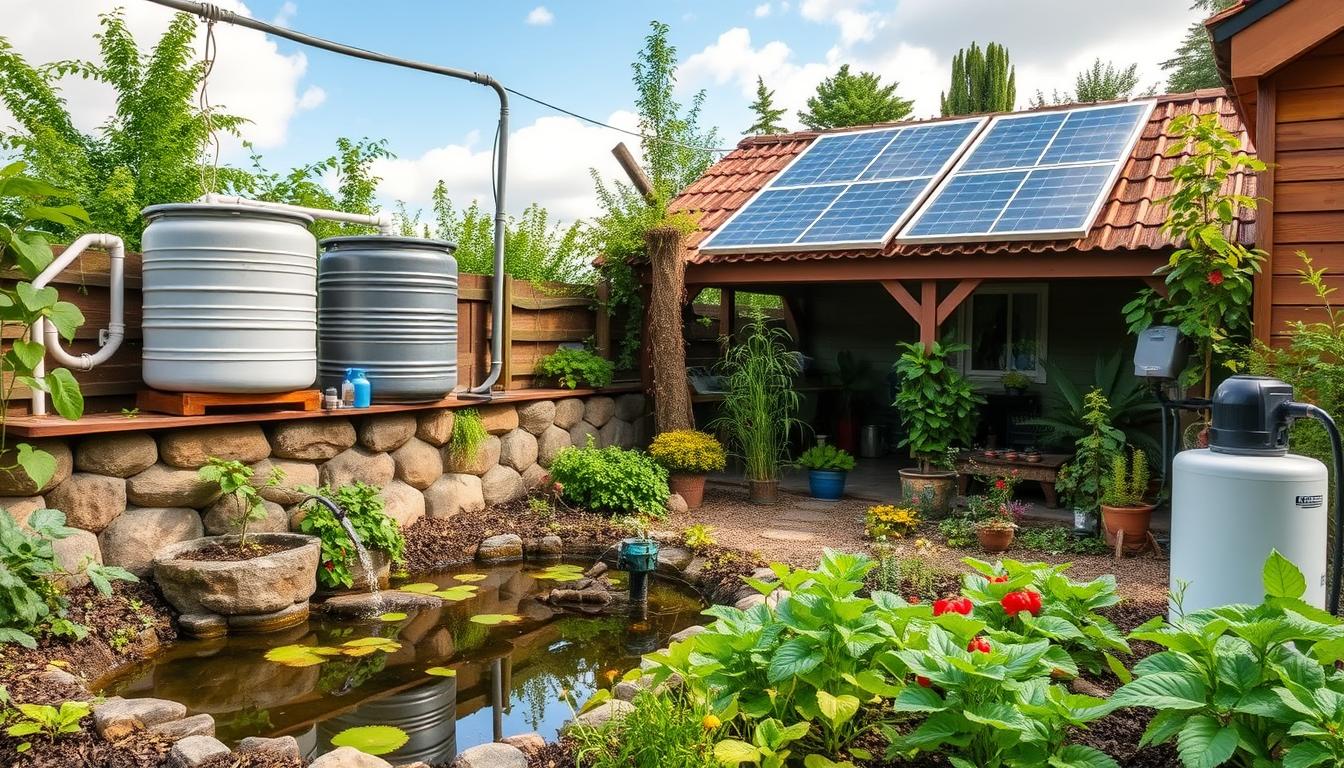In today’s fast-paced world, knowing how to fix and maintain your own home is key. It’s a skill that homesteaders, survivalists, and anyone who likes being self-reliant will find useful. This guide will teach you the important skills and methods for various home improvement tasks. It will help you take charge of fixing and keeping your home in good shape.
Key Takeaways
- Develop a DIY mindset to become more self-sufficient in home maintenance
- Discover the benefits of DIY home repairs, including cost savings and increased preparedness
- Acquire the essential tools and equipment needed to tackle a wide range of home projects
- Learn practical techniques for addressing common plumbing, electrical, and drywall issues
- Explore DIY painting methods to transform the interior and exterior of your home
- Understand the importance of homesteading and survivalist skills for self-sufficiency
- Prepare your home for emergencies with DIY repairs and maintenance
Embracing the DIY Mindset for Home Maintenance
Getting into a DIY mindset changes the game for home upkeep. It lets you save money and more. By doing things yourself, you gain independence and feel proud of your work.
Benefits of DIY Home Repairs
Doing DIY home repairs has many perks. You save money and feel more independent. Here are some key benefits:
- Significant cost savings by avoiding professional contractor fees
- Increased sense of accomplishment and pride in your work
- Improved understanding of your home’s systems and maintenance needs
- Flexibility to tackle projects on your own schedule
- Opportunity to learn new skills and expand your home maintenance knowledge
Essential Tools for DIYers
For a DIY project to succeed, you need the right tools. These essential DIY tools help with various home maintenance tasks:
- Hammer
- Screwdrivers (flat and Phillips head)
- Pliers (needle-nose and adjustable)
- Tape measure
- Level
- Utility knife
- Cordless drill
- Jigsaw
- Angle grinder
- Caulking gun
With your DIY toolkit ready, you’re set for many home maintenance tasks. Embrace the DIY mindset to boost your confidence and skills.
“The greatest wealth is to live content with little, for there is never want where the mind is satisfied.” – Lucretius
Plumbing Basics: Fixing Leaks and Unclogging Drains
Keeping your plumbing system in good shape is key for homeowners. From DIY plumbing to fixing leaks and unclogging drains, knowing how to handle home plumbing repair can save you time, money, and stress. We’ll cover simple ways to fix common plumbing problems and keep your home’s pipes and fixtures working well.
Identifying and Repairing Leaks
Leaks can cause water damage and increase your bills. First, check your plumbing for any signs of leaks. Once you find the leak, here’s how to fix it:
- Turn off the water supply to the affected area.
- Figure out what kind of leak it is, like a pipe, faucet, or fixture.
- Decide on the repair, like tightening connections, replacing washers, or using plumber’s tape.
- Follow the repair instructions carefully to ensure a tight seal.
Clearing Clogged Drains
Clogged drains are a big hassle, but you can often fix them yourself. Begin by using a plunger or drain snake to clear the blockage. If that doesn’t work, you might need to use a chemical drain cleaner or try baking soda and vinegar. Always wear gloves and goggles when using plumbing tools and chemicals.

“Mastering basic plumbing skills can save you a lot of money and hassle in the long run.”
Learning the basics of DIY plumbing helps you handle issues like fixing leaks and unclogging drains easily. Always put safety first and follow the instructions from the manufacturer when working on your plumbing.
Electrical Troubleshooting: Replacing Outlets and Switches
DIY electrical troubleshooting can seem tough, but with the right steps and safety, you can fix common issues like outlets and switches. We’ll show you how to diagnose and repair these parts. This will help you keep your home’s electrical system in good shape.
Safety Precautions for Electrical Work
First, make sure you’re safe when doing electrical work. It’s risky if not done right. So, always follow these key safety tips:
- Turn off the power at the circuit breaker before starting
- Use insulated tools to avoid electrical shock
- Keep the area well-lit and dry to prevent accidents
- Wear protective gear, like rubber shoes and safety glasses
- Never work on a live circuit; always check the power is off
Following these safety steps lets you safely do DIY electrical troubleshooting, like replacing outlets and switches.
“Electrical safety should always be the top priority when working on any DIY home repairs. Take the necessary precautions to ensure a safe and successful outcome.”
With the right mindset and attention to detail, you can become skilled in electrical safety. This way, you can easily handle basic electrical repairs. Safety first, and you’ll be great at DIY electrical troubleshooting.
Drywall Repair: Patching Holes and Cracks
Keeping your home’s drywall in good shape is key for a clean, professional look. If you have holes, cracks, or other damage, learning DIY drywall repair can be a big help. This guide will show you how to patch holes and cracks and get a seamless drywall finishing that makes your walls look new.
Techniques for Seamless Drywall Finishing
For a great drywall repair, the finishing touches are crucial. Here are the steps for a smooth finish:
- Check the damage and clean the area by removing any loose or crumbling parts.
- Put a layer of joint compound, or drywall mud, on the damaged spot. Use a putty knife or drywall knife to smooth it out.
- Let the compound dry fully, then sand the area to make it blend with the rest of the drywall.
- If needed, add another layer of compound for a smooth finish.
- Prime and paint the area to match the wall around it.
Using these drywall finishing techniques, you can get a professional look that matches your walls perfectly.
“With the right tools and a little patience, you can transform your home’s drywall from damaged to looking good as new.”
Painting Like a Pro: Interior and Exterior Tips
Unleash your inner DIY painting skills and transform your living spaces like a seasoned pro. Whether you’re tackling an interior makeover or freshening up your home’s exterior, these expert-level DIY painting techniques will guide you every step of the way.
Proper surface preparation is the key to a flawless finish. Start by thoroughly cleaning and sanding the areas you plan to paint, ensuring a smooth, dust-free surface. Next, choose the right interior painting or exterior painting products for your project, considering factors like paint sheen, coverage, and durability.
When it comes to application, the pros know that a quality brush or roller can make all the difference. Invest in high-quality tools and master the art of cutting in edges and achieving an even, streak-free coat. Don’t forget to plan your project meticulously, considering factors like weather conditions, ventilation, and drying times for optimal results.
Elevate your DIY painting game with these insider tips and techniques. With a little patience and attention to detail, you’ll be able to achieve professional-grade results and transform your living spaces with confidence.
Interior Painting Essentials
- Properly prepare surfaces by cleaning, sanding, and priming
- Choose the right paint sheen for each room and surface
- Use high-quality brushes and rollers for a smooth, even finish
- Apply paint in thin, even coats and allow for proper drying time
Exterior Painting Mastery
- Inspect and repair any cracks, holes, or damaged areas
- Select weather-resistant, durable exterior paint formulas
- Apply paint in the right conditions, avoiding direct sunlight and high humidity
- Finish with a protective topcoat to enhance longevity
Embrace your DIY spirit and tackle your painting projects with confidence. By following these expert-approved tips, you’ll be able to achieve professional-grade results and transform your living spaces with ease.
Homesteading Hacks: DIY Projects for Preparedness
DIY homesteading projects can change the game for self-sufficiency and preparedness. They’re great for both seasoned homesteaders and beginners. By doing things yourself, you can find many practical ways to boost your resilience and independence.
Creating a Self-Sufficient Homestead
Turning your home into a self-sufficient homestead takes a lot of effort. You can start by building rain catchment systems or energy-efficient greenhouses. Here are some tips to make your homestead thrive:
- Use DIY solar panels to get power from the sun. This cuts down on your grid use and helps the planet.
- Build a greenhouse or cold frame to grow food all year. This is key for fresh produce, even in tough climates.
- Try DIY greywater systems to reuse household water. This saves water and supports sustainable living.
- Learn about canning and food preservation. This way, you’ll have nutritious food ready for any uncertain times.
With these DIY homesteading projects, you can make your home a strong, self-sufficient place. It will be ready for any challenge and can help you survive and even thrive in hard times.

“The key to self-sufficiency lies in our ability to adapt, innovate, and take control of our own resources.”
If you want to get better at preparedness or make a truly self-sufficient homestead, there are many DIY projects to try. Use your creativity and problem-solving skills to make a sustainable living space. This will lead you to more independence and personal strength.
Survivalist Skills: DIY Home Repairs for Emergencies
When emergencies or natural disasters strike, knowing how to fix things yourself can make all the difference. This guide will teach you key skills for plumbing, electrical issues, and quick building repairs. These skills make you a self-sufficient homeowner ready for anything.
For plumbing troubles, like fixing leaks or clearing drains, you can keep water flowing during outages. Knowing how to fix electrical problems can also bring back your home’s power. These skills help you handle emergencies, keeping your family safe and comfortable.
Being able to fix things yourself is crucial in a crisis. It saves time and money and builds your confidence. By learning these skills, you become a DIY expert and a true prepper, ready for any challenge.







